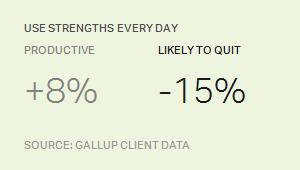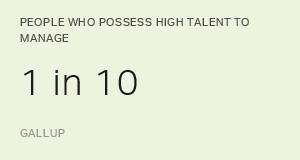Story Highlights
- Leaders should be open about their own strengths
- A decisive performance management system is key
- Have the right managers in place
How often are employees asked, "Do you get to use your strengths at work every day?"
Giving employees the chance to excel by doing what they do best every day seems like a no-brainer. In too many organizations, though, encouraging employees to know and use their strengths at work is limited to a guerrilla movement.
Yet some individuals, teams and divisions across virtually the entire Fortune 500 are finding ways to talk about and use their strengths. Thousands of people find out their CliftonStrengths® every day.
But on their own, grassroots enthusiasts can't make strengths-based development a bona fide part of their company's culture. That's because building a strengths-based culture isn't for the faint of heart. Without support from company leaders, individual managers who are focused on strengths are likely to be swimming against the tide, as conventional management wisdom is obsessed with fixing employees' weaknesses rather than building their strengths.
The potential gains of a strengths-based management approach are worth it, however. Gallup analysis reveals that people who use their strengths every day are three times more likely to report having an excellent quality of life, six times more likely to be engaged at work, 8% more productive and 15% less likely to quit their jobs.
What follows are the steps companies can take to create rich, vibrant cultural tapestries out of their employees' natural dispositions.
Have Leaders Who Know Their Own Strengths and Limitations
Introducing strengths-based development companywide requires executives to be involved. A promising place to start is to get leaders to be open about their own strengths and how they ask for support in their areas of limitation. By demonstrating that it's OK not to be great at everything, a leader sets a powerful example for the whole company. This can help employees waste less time pretending to be good at everything to get ahead.
Most successful leaders also know intuitively that a strengths-based approach works, because early on in their careers, they honed in on the things they did exceptionally well. The trick is to get leaders to encourage all of their company's employees to use their strengths, starting with their own direct reports.
One reason that a strengths-based culture makes a company stronger is because intellectual diversity makes teams more productive and better able to manage risk. A company's best partnerships and teams are formed with employees who are strong where others are weak.
Gallup's experience working with a bank bears this out. In a group of "act first, think later" types, a person who was initially perceived as hesitant, risk-averse and negative was able to think through all possible outcomes, not just the result the group was fixated on. This ability made this person the perfect choice to plan high-risk market entrance strategies. When a division leader realized this, his irritation turned into appreciation and a remarkably successful partnership was formed.
Build an Inspiring and Decisive Performance Management System
A strengths-based culture will not take hold if it clashes with a company's performance management philosophy. Even leaders and managers motivated to use their employees' strengths will find this difficult to do if developmental conversations and measurement systems are focused on fixing employees' weaknesses.
A strengths-based approach to performance management is straightforward, appealing and decisive. Managers conduct performance reviews that encourage and make use of employees' talents and that offer recognition and development in line with their strengths. They set demanding, achievable goals and provide clear performance expectations. The result is that employees feel their manager knows and respects them.
When it comes to dealing with weaknesses, managers following a strengths-based approach use three broad strategies. First, they can reshape the role to fit the person rather than vice versa. Second, they make it OK for employees who lack strength in an area to seek support from someone with complementary strengths. And last but not least, these managers face reality -- if the core requirements of the role do not match what the person is naturally good at, then that person should be reassigned.
Trying to fix people's weaknesses when they cannot change is demoralizing and drains their confidence and self-esteem. A highly responsible, hardworking school principal became stressed and ill because she lacked the focus and command to deal with low-performing teachers, and students were suffering the consequences. Once she recognized her strengths and limitations, she realized that she would never make a great principal. Instead, she stepped down from that role and -- using her gift for making others feel included -- became an outstanding assistant principal.
Use Strengths With Purpose
People enjoy the process of discovering what they are good at. But to make a difference to a business, employees' strengths need a clear purpose. Whether executives are looking to do more with fewer employees, delight customers or bring a new product to market, knowing what employees are good at and using this information with intent gives a company a better shot at success.
Employees who use their strengths at work tend to be more productive because the activities and demands of their job are more intrinsically rewarding, which in turn leads them to work harder. And managers who use a strengths-based approach no longer waste time trying to wring adequate performance out of employees who are unsure if what they can contribute is making a difference.
A large retailer was struggling to provide great customer service. To remedy this, the company trained its employees to offer shoppers personalized knowledge and advice about purchases, installations and repairs. When employees were also encouraged to use their strengths, they did an even better job of connecting with customers and providing crucial individualized service. Stores that implemented the new customer strategy and the strengths-based focus grew 66% faster than stores that didn't add the strengths-based component.
Develop Expert Strengths Coaches
Without expert coaches, it can be difficult for some employees to figure out what they are naturally good at, and stereotypes can hold sway. For example, Paul feels he is not a people person, and he'd rather walk over hot coals than seek out new prospects in a cold convention room. But an expert strengths coach sees that Paul develops deep relationships with clients and encourages him to build on that strength -- and those relationships become crucial to the company's survival when the supply chain seizes up.
An investment management company has rapidly grown into one of the foremost players in the U.K., in part because it has internal experts who help their employees use their strengths effectively. The company's fund managers perform at their best in a competitive and changing market because coaches have a subtle understanding of their strengths and limitations and an ability to influence hard-nosed performers who are often set in their ways.
Without expert strengths coaches, the high level of interest shown in an employee's strengths at the point of hiring or promotion subsequently dims. Human resources professionals with a desire and aptitude to coach can become experts in strengths, coaching employees and ensuring they play to their strengths at work every day.
Have the Right Managers
To bring a strengths culture to life, it helps to have managers who are naturally wired for the job -- who are curious about what makes people tick and get a buzz from helping people hone their strengths. Such managers readily learn what happens when an employee's strengths are ignored, overplayed or misunderstood. The best managers put teams together with a forensic eye for employees' individual and collective dispositions -- and they do this as a strategic imperative, not a last-minute exercise based on who is available.
When employees feel strongly that their manager focuses on their strengths, their engagement is almost guaranteed. Consider the example below of a sales force at a medical devices company.

We've learned from our work with clients that it's far easier for managers to focus on their employees' strengths if both managers and employees were hired for their fit to the requirements of the role and the company's culture in the first place. When an employee's natural disposition diverges too much from what is required to do a job well, a strengths approach will only serve to highlight his or her unsuitability to the role and, possibly, the company.
These are the five steps companies need to take to build a strengths-based culture. If companies don't put the right conditions in place, employees feel embarrassed to say that they are not great at something; they stay stuck in their routines and muddle through. It's just so much better -- for employees and their company -- when employees feel they are being their best selves.


